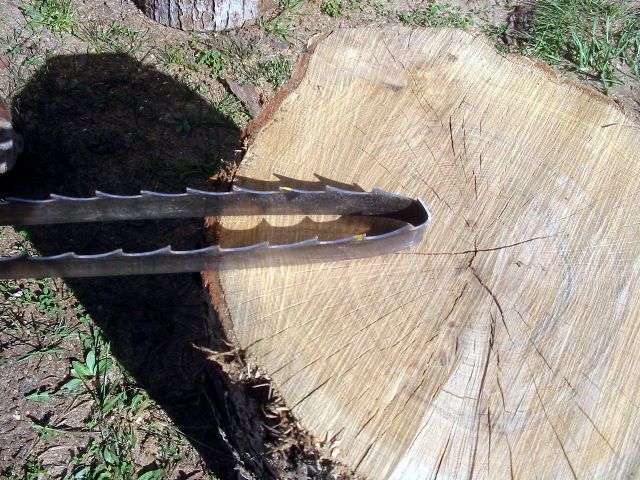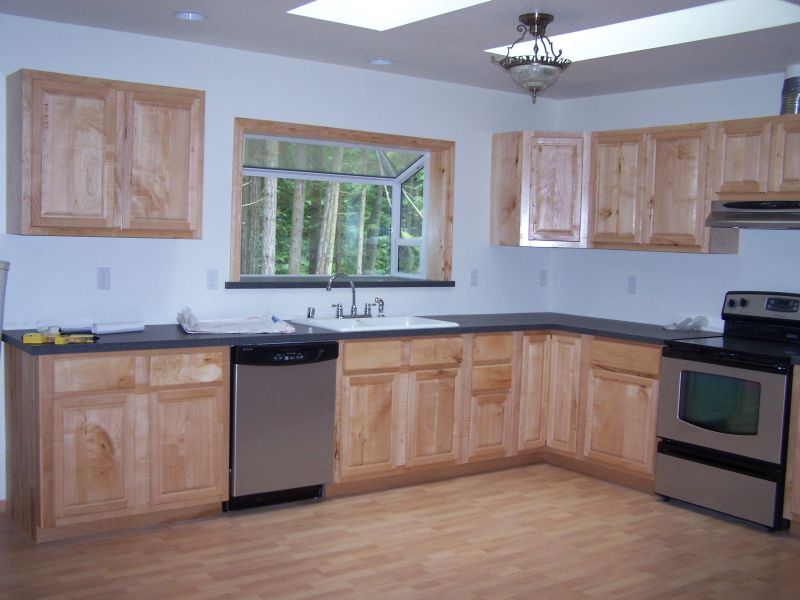Question
After all of the research and testing of mills, I decided on the Logmaster. I should be receiving it within the next two weeks. When I was at Timberking getting a demo, they told me of a new blade they were using that could supposedly be sharpened a lot more than the 3-5 times that seems to be the industry standard. Have you tried the blades? There could be considerable savings if you could extend the life of your blades.
Forum Responses
(Sawing and Drying Forum)
From contributor L:
I know nothing of this blade. If we look at blade life we will find that, if the entire profile is ground, the only difference between a new one and one that has been sharpened several times is the distance from the back to the tip is slightly smaller. All other considerations are the same; if sharpened correctly, tooth chemistry is the same. The life of the blade comes from going around the two wheels and straight between them. This bends the blade back and forth until small cracks start at the gullet and move to the back until breakage if not pulled first. Wood-Mizer says approximately 3000 to 4000 bf per blade. You can sharp 3 to 10 times during the 3000 to 4000bf. The limiting factor is how many times you can bend a blade before it breaks. Research why the blade you seek claims to go around the wheels more times.
With all due respect to my friends at Wood-Mizer, it's really impossible to rate this in terms of board feet because if you're cutting 2 inch material you'll get twice as many bft from a blade than if you're cutting 1 inch; 3 inch you'll get three times, etc. Much depends on what you're cutting: species, feed rate, how clean the logs are (that's huge), etc. There are no definites in sawmilling!
Also keep in mind our customers who have had the very positive experiences with many resharpenings have been using mills with belted wheels. It's our opinion (admittedly not shared by everyone in the industry!) that belted wheels significantly improve blade life by offering a more forgiving surface for the blade to ride on. I don't know a lot about the Logmaster, but if memory serves it's a solid steel wheel?
But all else being equal, our experience is that the Ultra Max will provide longer life than competitive blades. One reason is the teeth are hardened more deeply, which means you can grind more off and still have hardened tooth left.
No offence to contributor W, but I highly recommend Timber Wolf blades (Suffolk Machinery). They have outperformed every other blade manufacturer out there in longevity and customer and technical support. It has been my experience that sawmill companies specialize in sawmill construction, and blade companies specialize in blade construction.
As for private labeling, do we have a foundry producing blade steel exclusively for us? No, nor do any other mill manufacturers (no matter what they might imply). But the Ultra Max is our proprietary blade, available nowhere else.
As far as problems with Timberwolf, I did have an issue with an entire box (a dozen) having bad welds and all broke on the joint. It was with some division of their company that was just set up and the guy running it didn't know what he was doing. I was upset about my time consumed in the bad experience, but TW did sent free replacements and 4 or 5 free extra blades as compensation.
I really did like the TimberKing but one thing kept me from buying it. I am expecting my mill to be on the road a lot and the travel package that TK offered didn't appeal to me. I own property in Missouri and Oklahoma and expect to travel between them. Your man that gave me the demo did a fine job, and as you can tell by my inquiry into your blades, may have sold me on them unless you're telling me that they may not be as effective on the solid steel wheels.
Logmaster does have solid steel band wheels. I know there's all kinds of varying opinions on that but not having first hand experience I relied on feedback from this forum and what research I could do on the net. I am going to try your blades and hope they will work as your man implied they would. I will probably never stop shopping for the best blade for me, as I assume all of you are doing. I will be cutting almost exclusively hardwoods.
I have tried lots of blades and over the years found that the WM double hards in 0.045 10 degree work well on my LT40 and the many different woods I saw. The 7 degree work very well in hardwoods but not so well in SYP. So once you get your mill do not be afraid to try a different blade. Some makers will send you a free one to test. But once you saw very much you will find one that suits your needs and works on your machine.
Lennox was the brand of blade I found that would take the most sharpening, but after about 3 grinds the life between sharpenings went down. My blade cost is a bit less than 1 cent per bdft. My WM blades last about 600 bdft in oak and close to 1,000 bdft in pine and ERC but I have a de-barker on my mill. My LT70 blades average about 200 bdft more than the LT40 blades. Thinner blades last longer than thicker ones but thicker ones will cut faster and flatter if you have the HP to pull them through the wood.
We have standardized on one blade for hardwood sawing – the .045x1.25 Wood-Mizer DoubleHard 7 degree blade. You can stay awake nights wondering if you have the best or longest lasting blade made but I’ve not lost any sleep over the decision we’ve made.
We started out years ago sharpening our own blades. Then we used Wood-Mizer ReSharp service for years. Just last year we bought a new Wood-Mizer CBN grinder and dual-tooth setter and got back to rollin’ our own again.
One major difference is that when I sent blades to ReSharp they would reject a blade that had been sharpened say 5 times as being too narrow to resharpen. I have found with our own sharpener that it’s difficult to sharpen a .045 x 1.25 blade to death. That is until it breaks.
Below is a picture of one that I’ve lost track of how many times it had been resharpened by ReSharp service and by myself. Probably at least 10 times. It had got to where it was only about 1.00 wide. That is .25” of material had been sharpened away! I found I was at the point of diminishing returns trying to use these blades until they broke. They were so narrow I suspect the guides were removing the set. Also, I figure all the hard part of the tooth was gone. I decided to break it and dispose of it (and ones like it) once and for all. I found it difficult to step on it in on the packed ground and break it. It still had that much flex life in it.

Try all the blades you like, but I still highly recommend Timber Wolf blades. I tried TK, WM, Lenox, Simonds and Timber Wolf before I stuck with them. I think Lenox makes the worst sawmill blade ever. Maybe it's just what they offer in my mill size or a bad blade, but it was horrible. Timber Wolf offers two basic types for sawmills, the regular Swedish steel ones I buy all the time, and they have Cobalt blades for when I do barn beam work. I still have to remove all the nails, but if I miss a few the blade can handle it and still cut flat.
Steel comes in all ranges of formulation from hard tool steel to some that’s as soft as tinned lead that you could carve with a pocket knife. Each has its own mechanical properties and applications. The configuration of the steel – be it pipe, square/rectangular tube, I beam, channel, angle, bar stock, etc. and how it’s loaded makes a big difference. As does the design of the product – spans, if the joints are fully welded, stitch welded, bolted, have gusset plates, etc. So just knowing how thick or how heavy is only a part of a much larger equation.
Band mill blades are a consumable. Blade expense will run about one cent per board foot. If you have extra clean logs and easy to saw logs you may gain a little. If you saw only dirty, hard logs, you’ll lose a little. But I figure if you buy high quality blades you’ll pay more but should gain back in longer sawing time and more resharps. If you buy low cost blades, they won’t saw as long between sharpening or last as long.
One way we lower our blade expense is to buy them in bulk. Most vendors have some cost break point where they discount their price. They will often allow you to mix box units of tooth configuration.
Contributor P, if you're cutting low grade logs all the time, your idea of cheap blades makes perfect sense. I saw quality logs just about every day I am running my mill and I know better blades pay off for me not just in blade run time gains, but my time saved from changing blades less often. I find that a little price difference in a better blade invests better return in many aspects. Once in a while some custom sawing job or that one bad tree off a logging site contains something I don't know that damages a blade and makes my day. Keeping a few low grade blades around in inventory for questionable logs is not a bad idea.
We have an inventory of old blades that I use on logs that are suspect of having metal.
Whether it's the blade thickness or the brand, I believe this tiny bit of rigidity makes a night and day difference not necessarily in a little bit more added blade longevity while on the mill (per use not per resharpening), but a major difference from the second I start my mill up with a fresh blade.
If you ever come up with a .045 blade to fit my mill I would happily buy some and never expect you to give me more for free. Again I do appreciate the blades you gave me for free. There are more in the box than you said there would be. They do cut wood and I made money with them, but this was a gamble on your part for an honest performance test. Please keep me updated on a .045 blade. Thank you.
